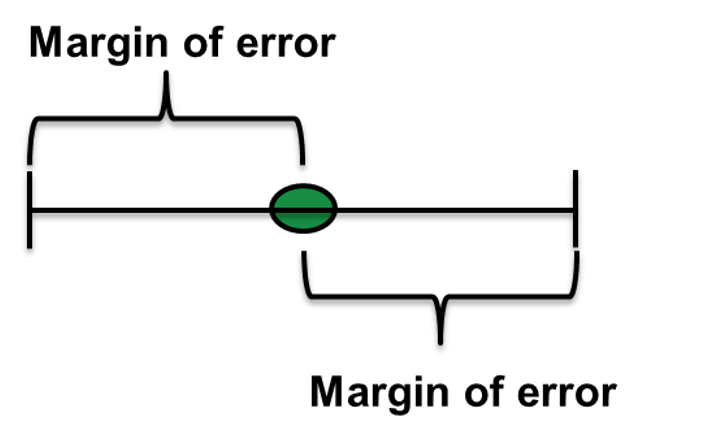Slides 📊
9.3. Precision of a Confidence Interval
In the previous section, we established that confidence intervals convey the degree of uncertainty through their width. A narrow interval suggests high precision, while a wide interval reflects greater uncertainty. This naturally raises two key questions:
What factors determine the width of a confidence interval?
What can we do to make an interval more precise (narrower)?
We will explore the answers to these questions in this lesson.
Road Map 🧭
Identify the three building blocks of a margin of error and understand how each influences the precision of a confidence interval.
Understand why the sample size is the only component of an ME that researchers can actively control.
For a desired level of precision, compute the mininum required sample size, and incorporate this into experiment planning.
9.3.1. What Makes a Confidence Interval Precise?

Fig. 9.5 The width of a confidence interval is equal to 2ME
The width of a confidence interval is entirely determined by its margin of error (ME) as shown in Fig. 9.5. Specifically,
From its mathematical definition, we can identify three elements that determine the size of an ME: \(\alpha\) (and thus \(C\)), \(\sigma\), and \(n\). Let us examine how each affects the width of a confidence interval.
Component of ME |
Effect on precision |
|---|---|
Confidence level \(C\) |
Higher \(C \to\) the central region of area \(C\) expands \(\to\) \(z_{\alpha/2}\) pushed to the right \(\to\) increased ME & lower precision 
Fig. 9.6 Standard normal PDF |
Population standard deviation \(\sigma\) |
Higher \(\sigma \to\) increaseed ME & lower precision |
Sample size \(n\) |
Higher \(n \to\) decreased ME & higher precision |
Controlling the Precision
Of the three components of a margin of error, researchers can practically control only the sample size, \(n\). The population standard deviation \(\sigma\) is a fixed property of the population, and the confidence level \(C\) must be chosen to reflect the desired rigor of the experiment; it is not meaningful to lower confidence merely to obtain a narrower interval.
This leads to an important practical question: “How do we control the sample size to meet a target precision?”
9.3.2. Sample Size Planning for a Target Precision
Maximum Width
Suppose we want to construct a confidence interval whose width is at most \(w_{max}\). That is, we want
Rearranging to isolate \(n\),
Square both sides and bring \(n\) to the left hand side:
Since \(n\) must be a whole number, we take the the smallest integer on or above the lower bound. That is, the smallest required sample size \(n^*\) for a target width \(w_{max}\) is computed as:
Maximum Margin of Error
The desired level of precision can also be given as a maximum margin of error, \(\text{ME}_{max}\). In this case, we take \(n^*\) as:
through a similar flow of logic. You are encouraged to confirm this result as a quick exercise.
Example 💡: Weights of American Adult Males, Continued
We continue with the study of weights of American male adults from Section 9.2. Suppose the researchers want to compute a 99% confidence interval for the mean weight with a margin of error of at most 1. What is the smallest sample size they need?
The building blocks
The maximum ME: \(\text{ME}_{max} = 1\).
The population standard deviation: \(\sigma=49.26\) lbs
Confidence level: \(99\% \, (C=0.99, \alpha=0.01)\)
The z-critical value: \(z_{\alpha/2} = z_{0.005} = 2.5758\)
The goal
We would like to compute the smallest integer \(n\) satisfying
Rearranging and isolating \(n\),
The smallest sample size needed for the desired level of precison is \(n^* = \lceil 16099.53\rceil =16,100\).
9.3.3. Bringing It All Together
Key Takeaways 📝
The margin of error quantifies the precision of a confidence interval. The three factors of margin of error that control precision are: confidence level \(C\), population variance \(\sigma^2\) (or population sd \(\sigma\)), and sample size \(n\).
The smallest required sample size for a given maximum ME can be calculated using: \(n^* = \Big\lceil \left(\frac{z_{\alpha/2}\,\sigma}{\text{ME}_{max}}\right)^2\Big\rceil\).
Exercises
Sample Size Planning: A battery manufacturer wants to estimate the mean battery voltage with a margin of error of \(0.05 V\) at 99% confidence. Past data suggest \(\sigma = 0.21 V\). Calculate the required sample size.
Cost-Effectiveness vs Precision: Why is it generally not cost-effective to seek extremely narrow confidence intervals (e.g., reducing margin of error below 1% of the estimate)? Provide both statistical and practical justifications for your answer.